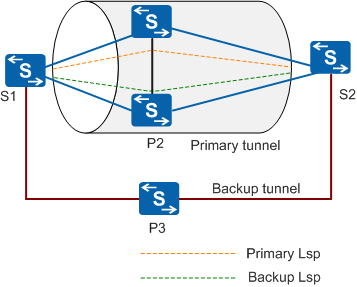BFD for MPLS TE
BFD for MPLS TE is an end-to-end fast detection mechanism in MPLS TE that quickly detects faults along the link in an MPLS TE tunnel. Traditional detection mechanisms, including RSVP Hello or RSVP summary refresh (Srefresh), detect faults at slow speeds. BFD uses fast packet transmission to quickly detect faults on MPLS TE tunnels. When an MPLS TE tunnel fails, BFD triggers fast switchover to protect services.
BFD detects faults on the following types of MPLS TE tunnels:
Static BFD for TE CR-LSPs
Static BFD for TE CR-LSPs uses a manually configured BFD session to quickly detect faults on CR-LSPs.
Static BFD for TE tunnels
Static BFD for TE tunnels uses a manually configured BFD session to monitor the whole TE tunnel and trigger traffic switchover of applications such as VPN FRR.
Dynamic BFD for TE CR-LSPs
Dynamic BFD for TE CR-LSPs plays as static BFD for TE CR-LSPs. Dynamic BFD for TE CR-LSPs uses a dynamic BFD session instead of manual configuration.
BFD for TE tunnels and BFD for CR-LSPs report faults to different objects. In BFD for TE, BFD notifies applications such as VPN of faults and triggers traffic switchover between different tunnel interfaces. In BFD for CR-LSPs, BFD notifies TE tunnels of faults and triggers traffic switchover between different CR-LSPs in the same TE tunnel.
BFD is bound to an LSP and a BFD session is established between the ingress and egress. A BFD packet is sent by the ingress to the egress through an LSP. Then the egress responds to the BFD packet. In this way, a BFD session at the ingress can quickly detect the status of the path through which the LSP passes. Once BFD detects a link fault, it notifies the LSP management module. Traffic is then switched to the backup LSP.
Application
BFD for CR-LSPs
In Figure 1, an active tunnel has been established between S1 and S2 and hot-standby LSPs have been configured. On S1, a BFD session is established from S1 to S2 to detect faults on the primary LSP of the TE tunnel. If a fault occurs on the primary LSP, the BFD session quickly notifies S1. After learning the fault, S1 fast switches traffic to the backup LSP to ensure nonstop traffic transmission.
BFD for TE tunnels
In Figure 1, the primary tunnel is established along the S1-> P2 -> S2 path, and the backup tunnel is established along the S1 -> P3 -> S2 path. A BFD session is set up along the S1 -> P2 -> S2 path to monitor the primary tunnel. If a fault occurs on the primary tunnel, the BFD session quickly notifies S1. After learning the fault, S1 fast switches traffic to the backup tunnel to ensure nonstop traffic transmission.
